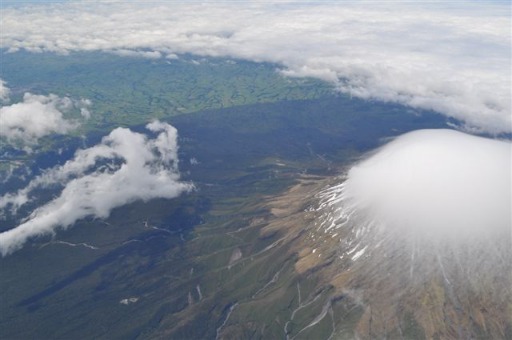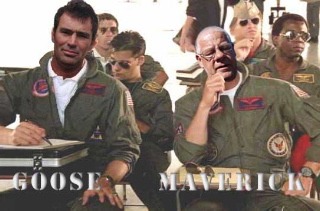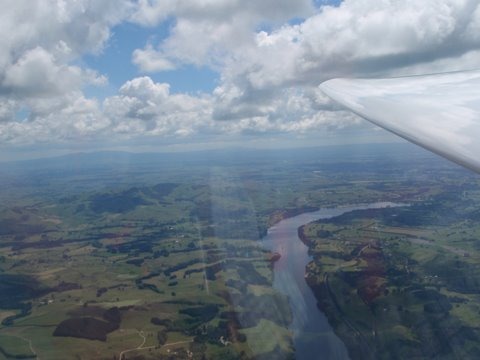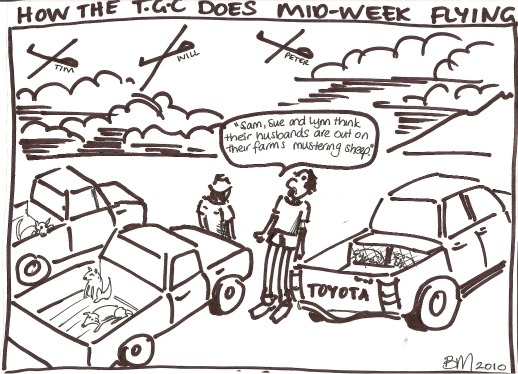Newsletters > December 2010/January 2011
|
|
December 2010/January 2011Newsletter & Roster December 2010 & January 2011 Date Tow-pilot InstructorDecember 4 McKay Hardwick-Smith 12 McFadgen Williams January 8 TBA Hardwick-Smith 9 .. Hardwick-Smith 15 .. Williams 22 .. Tullett 23 .. Tullett 29 .. Williams The Month That Was: November turned out to be a good month for us with some good flying. Glyn Jackson went solo in WZ on the 2nd and did his QGP duration flight by staying away for an hour. Could have got his silver height too if he’d had a logger on board. It was a good sea breeze front day and everyone had good flights. The 9th was a winch day with two launches getting away for 49 & 60 minutes respectively. The 16th was a wave day and John Tullett and Tim Hardwick-Smith got to 15000ft out over the mountain. Stirring stuff!! That sort of thing makes the rest look mundane but the 23rd saw three flights. One for Tim in the Discus for 2hrs 10m and a couple of flights for Steve Barham and Peter Miller in WZ. The 27th provided two trial flights, a flight for Steve and three for Gene Campbell. The Taranaki Daily News came along on Sunday the 28th to get material and photos for a feature article which appeared on Saturday December 4th. That day got better and better as a sea breeze front formed and hung around for the rest of the day. Guy Lane had a trial flight that made up for the fact that he couldn’t quite see the mountain, Will Hopkirk hurtled into a paddock out Te Popo way and everyone else cruised to and fro along an energy line which did all the right things by us. Ralph Gibson and Nick Wisnewski from Norfolk joined the party. Will was retrieved by Jim McKay with RWS assisted by Jim Finer who just happened along in JTA. As well as all this, Will Hopkirk and John Tullett took the PW5 to Matamata and the stories of their time there are in this edition. Good stuff all round. Stats: Aircraft Time Flights WZ 15hrs 02m 36 TE 10hrs 46m 8 XC 4hrs 2 IA 3hrs 05m 1 RWS 2hrs 55m 20 Winch 13 launches There were two or three QGP evenings too and there remain just the Human Factors and the second of the radio procedures to be held. Some-time in January.  Wave flight 16/11/2010. Mountain, cloud cap and rotor cloud. Hangar Extension: No progress since the last report. I guess it will be after the New Year before work resumes. The floor looks quite wet with all the rain we've had and no gutters/drainage in place. Never mind, it will be finished!  As it is. And now, let’s hear it from Matamata:-  “ and then maverick Tullett went inverted over Clinton to give him the bird” Top gun Gliding cross-country course Getting off the farm for a week in November was always going to be a big ask, so when one of our shepherds resigned, I thought the course might have to wait a year. However, Sam and the crew seemed to have things under control so off we went. John Tullett (call sign Maverick) made a great start with a dogfight with the Otorahanga traffic police - oops.I was pretty nervous about the course, flying from a new and busy airfield, going cross country and having to pee in-flight. However I didn’t have a monopoly on nerves and the first session was talking in depth about paddock landings and paddock selection with aerial photos on a data projector screen. The Task on day one was to fly down towards Thames, Tirohia Bridge, then up to Hinuera and finally back to the field. I flew with an instructor, Roger Brown in the Puchacz. The best advice he gave was about picking a thermal with a landable area nearby then not stopping for each scrap of lift on the way. We didn’t make the southern turn-point but I was feeling a lot better about my flying and the course in general. John had flown the PW5 and found his loving feeling (PW5) somewhere out there, (he’d previously lost it). Day two Ridge and wave flying presentation from Roy Edwards was good stuff but no wave or ridge flying today. The task for day two was 78 km round trip from Matamata to Ngapuhi Dam then across to Tirau then back to Matamata. John was with an instructor in the Janus however the teaching style was more demonstrating than critiquing. I got away early, flying solo and after a bit of hard work at Hinuera, had a great flight – probably the highlight of my gliding career so far.  Crossing Karapiro at 4500 ft Day three My trace analysis from the previous day showed some good thermaling and some very average thermaling as I got more tired. The talk for the day was on navigation and getting the best out of air traffic control. The sea breeze front was on its way so we got going. I was in the Janus with Roy Edwards. The task was to fly from Flaxmill, near Thames then to Atiamuri and home, 220km round trip. We made it! Roy coached me on criteria for going or staying at different thermal strengths. He also noted that the sea breeze was coming in waves and that the thermal we were in could reboot given time which proved to be the case. We opened airspace adjacent to Putaruru to 7000ft and had a great final glide back to the field 60 km at 100 knots. Maverick landed out (possibly behind enemy lines) but was back in the bar by supper. Day Four Today’s talk was on flight recorders, flight analysis and pros and cons of the various systems on the market. John was flying with Russell Thorne. Russell is a 777 pilot for Air NZ and a really nice guy. I was solo and putting my new found skills to use in the PW5…. Reality check time after a half hour sled ride I found myself visiting Mr Farmer. At this point my call sign Goose seemed to make sense. I informed Mr Farmer of my landing, to which he replied did you land in my cows? I replied “ hell no that would have been crashing not landing” this calmed him considerably and the invite to the land-out dinner had him quite friendly. Day Five The briefing was by Trevor Terry talking about the preparation for cross –country flying and had some real gems around mental attitude and preparation. He has a set of comprehensive check lists and pre flying routine that has any negative stuff covered (land outs, recoveries, gear failures etc) so he can concentrate on the flying. He told us of some of his 300 plus land-outs as being an accepted part of adventure soaring. Bill Mace who ran the course spoke about the gradual process of expanding our comfort zones with knowledge and experience whilst avoiding the zone where fear clouds our judgement and causes us to make bad decisions. This reminded me of some sports coaching years ago where I was told there is no such thing as a bad decision, some are definitely worse than others, however making the decision implies progress and the next step is implementing the plan with the appropriate level of precision minimizing the risks. (Rugby coaching believe it or not) The weather was looking lean so after a false start we packed up and headed home.  “interesting gliding platitude shared by retrieve crew” Take home messages • Paddock landings need to be part of your current skill set to be safe in the glider whilst going cross country • With a paddock in reserve think up and look at the clouds to go up • Take more holidays (nothing to do with gliding but still important) • The glider is powered by your mind • Jet wash turbine failures may be integral to the top gun story but land-outs are just another day on the gliding course. John Tullett’s take on the week at Matamata. • Last week Will and I took part in the cross country course at Matamata. The format was to have alternate days flying with an experienced cross-country instructor and flying solo, applying what had been learned. In the mornings we had lectures and in the evenings, we had a meal together and an informal debriefing. • We arrived on Sunday night, with the PW5 and a speeding ticket, rigged the glider and met the other 10 participants. • Monday saw me in the PW5 and heading of to Te Aroha and then to Hinuera and back to the airfield. • Tuesday I went South in a Janus with Maurice Weaver from Tauranga, and experienced the joys of a long legged, flapped machine. • Wednesday saw me land out at a place called the Swamp in the PW5 • Thursday was the day for me. I flew with Russell Thorne in a PW6. We covered basically the same task as I had done on Wednesday, without the land-out. He is a very patient man. We spent the first hour with him attempting to get me to turn at a constant angle of bank and at a constant speed........ • By constant I mean within 1 knot of 50 knots !!!!!!! • The reason is as follows. If you are in a thermal and you are flying at 50 knots, you have a margin of controllable flying speed for when the lift dies a little, and you can put the nose down to bring it back to 50. When you fly into an area of greater lift, the speed goes up and you bring the nose up until you’re back at 50. This converts the extra speed into height, and you practice it until the airspeed indicator doesn’t move off 50. Ten feet here and twenty feet there, adds up on a weak thermal day or when you want to aximize the climb. • You may have guessed that this is the most important thing I got from the week. • Close second were the company of like minded people and Jan Mace’s Thursday lunch ( chicken, apricot and camembert cheese whole grain sandwich ). And now a word from your CFI on Competition Finishes: 1. First make sure no one else is in the in the circuit and just because the radio is quiet doesn’t mean there isn’t anyone around. There are a couple of NORDO microlights based at Stratford and the K7 doesn’t have a radio – it is not a requirement to have a radio at Stratford airfield. It could also be someone with a flat battery or on the wrong channel who think that everyone can hear them. So first of all have a good look out or better still talk to a ground base radio and ask them to check. 2. Give a radio call “Stratford Traffic, Glider XYZ, downwind, approach and overshoot, two seven. 3. Don’t start from below about 900 ft or you won’t have enough energy to get back up to a safe altitude to do a safe circuit and also no higher than 1000ft or there could be a danger of ending up going too fast. It isn’t easy to monitor your airspeed when you are bouncing along at 120 knots. 4. The rules for a competition finish state that you must not go lower than 50ft or closer than 75m to any person, aircraft, vehicle or building. 5. Don’t stay low and fast for any longer than necessary as the glider will be losing energy quickly. 6. Pull up very gently and level off before the glider stalls. You should be at 500ft or higher for a safe close circuit, but with no height to spare to give way to any other traffic. Don’t forget the pre landing checks, especially the undercarriage. 7. Don’t go too low the first time you try it –say 300ft. 8. Don’t try it in the PW5 (I have and it doesn’t work) Talk to me first and get cleared to do it. Tim Hardwick-Smith. 25 Years Back: Sandy Norman visiting and checked out Chris Griffin and Louis Trichard as trainee instructors. No flying on the day. October was not a good month for flying. John Schicker’s Skylark 2 glider test flown by Bob Struthers at NP Airport. John & BM up at Matamata with Jim Chaplin & his Cirrus HP. The raffle to close on 23rd November. Only 50% of subs had been paid by end of October. Still looking for another towplane. Saturday flying resuming from 8th December. Rod Smith, John Carter and Erwin Oberhumer pass the C Certificate exam. John and Erwin both did paddock landings with the CFI in the back of the Rhonlerche in Millar’s paddock. Flying a bit better during November. Chris Griffin and his passenger overhead the TV translator on the mountain at 4500ft. Christmas Camp at German Hill from 4th to 12th January. (Those were the days.) Finally, a Merry Christmas and a Happy New Year to everyone. And there should be some good flying to come, I’m sure. Papa Mike.  |
